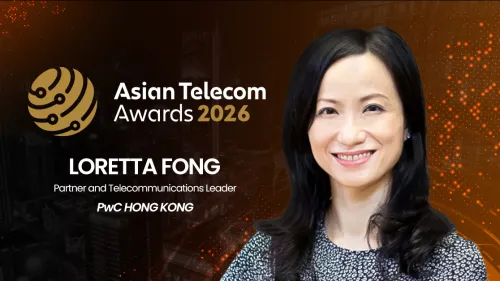
5G for telcos: Deloitte’s Yang Chi Chih emphasises enterprise potential, custom network services for growth
This strategic approach not only ensures robust revenue growth but also positions telcos at the forefront of innovation.
Marked by the surge of generative artificial intelligence (Gen AI) and the pursuit of sustainable practices, Asia's telecommunications industry has undergone a transformative journey in the past year. In this ever-evolving landscape, telecom operators grapple with challenges and opportunities that demand strategic foresight and innovative solutions.
Yang Chi Chih, Technology, Media & Telecommunications Industry Leader at Deloitte Southeast Asia, brings over 25 years of extensive experience to the forefront, providing valuable insights into the evolving telecom ecosystem.
Chi Chih leads Deloitte's Audit & Assurance practice in Singapore and plays an active role in the telecommunications and technology sectors across Singapore, Southeast Asia, and South Asia. With his wealth of experience in public accounting, Chi Chih has established himself as a trusted advisor for a diverse range of clients, including local, multinational, and listed companies in Singapore and Southeast Asia.
As part of the judging panel for the Asian Telecom Awards 2024, Chi Chih shares his perspectives on the current state of the telecommunications industry in Asia, delving into topics such as the impact of AI on network improvement, the implications of market consolidation, and the imperative for sustainability practices.
How has Asia’s telecom landscape evolved in the past year, and what should industry players watch out for?
It has been only a year since Generative Artificial Intelligence (Gen AI) surged to prominence. Gen AI has created new frontiers for personalised marketing, customer service, and content creation in the telecom industry. Telecommunications (Telco) operators are looking to leverage AI in two broad categories.
Firstly, network improvement – AI can reduce network operational expenses (OPEX) in various ways, such as network management and optimisation, automatic network configurations, fraud detection, and traffic prediction and management.
Telco operators also seek to leverage AI to enhance customer experiences through content optimisation and customer service chatbots or assistants.
There are two areas industry players should keep an eye on in the coming years.
The first area is continued market consolidation. The Asian telecom market has seen several Mergers & Acquisitions (M&As) in recent years, driven by the need for scale and efficiency to compete effectively and to increase shareholder value. This has been a bugbear for most telcos that have faced challenges in growing their core income. This trend is expected to continue in the coming years, and we foresee there being fewer but larger players in the market.
The second area is the implementation of sustainability practices. Companies should consider reducing the amount of energy and raw materials required to manufacture devices and increase connection speeds. This requires innovation and commitment but is crucial for the industry.
Deloitte’s Global Technology, Media and Telecommunications Predictions 2024 report highlights that telecommunications is not the worst carbon culprit – it connects 95% of the planet but is only responsible for 2% of emissions. However, the industry can do more to become more sustainable. Telco companies can reduce their carbon footprint by shutting down copper wire and 3G wireless networks, which use a lot of power whilst serving only a few customers, changing their field service fleets to electric vehicles, and switching to 5G radio gear that has a “snooze button” to enable them to go to sleep when not in use. These can save telcos gigawatt hours of energy and megatons of carbon dioxide equivalent annually.
Telecom players in Asia are currently venturing into mergers to boost profitability and reduce redundancies. How do you think this will affect consumers and how can they mitigate risks associated with such moves?
Reduced competition due to mergers could lead to fewer options for consumers. However, the benefits could outweigh the drawbacks, as M&As might yield synergies and cost savings that can be ploughed back to improve overall customer experience. Network integration will also enable consumers to benefit from stronger and better coverage.
The impact of telecom mergers on consumers in Asia will depend on various factors, including the specific companies involved, the regulatory environment, and the effectiveness of the integration process. Consumers can mitigate risks by considering four key factors. Firstly, staying up to date with merger developments to assess their potential impact. Secondly, comparing pricing and service offerings from different providers to obtain the best value. Thirdly, carefully reviewing any changes to contract terms and conditions arising from the merger and finally, being prepared to switch providers if the services fall short of their expectations post-merger.
Why do you think it is important for telecom companies to stay ahead of the 5G wave in the region amidst a growing demand for stronger connectivity?
With the wireless consumer market nearing saturation, telcos can unlock significant revenue opportunities by prioritising the enterprise segment. 5G's compelling enterprise use cases are poised to drive robust revenue growth, making it crucial for telcos to stay ahead of the 5G wave. Network slicing, a key enabler of enterprise 5G private networks, enables telcos to offer customised network services tailored to diverse business needs, creating new monetisation models and propelling their future growth.
Being a part of the elite panel of judges for this year’s Asian Telecom Awards, what are the qualities you looked for in evaluating the entries?
I kept an eye out for entries that demonstrated four key qualities: innovation and impact, leadership and vision, strategic execution and business acumen, and scalability and sustainability.
















